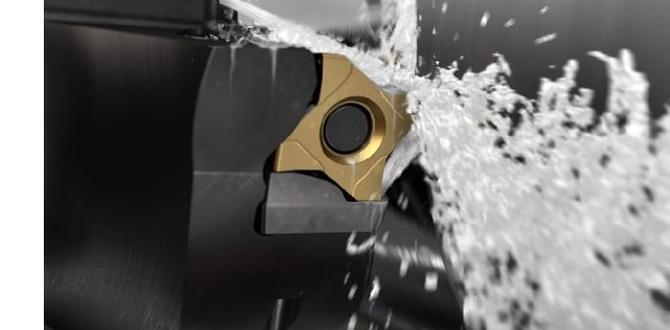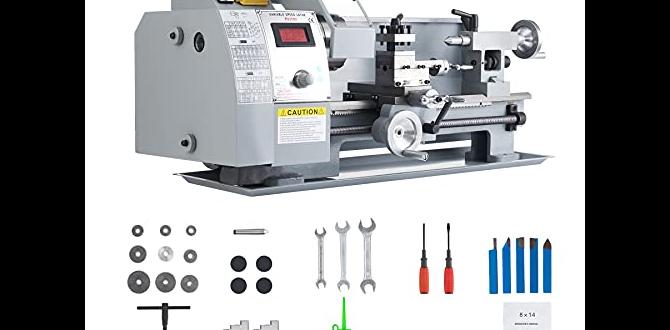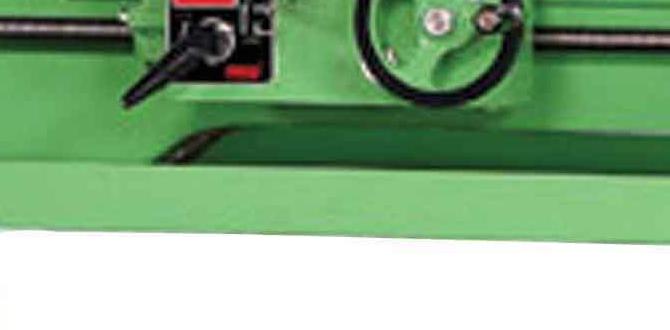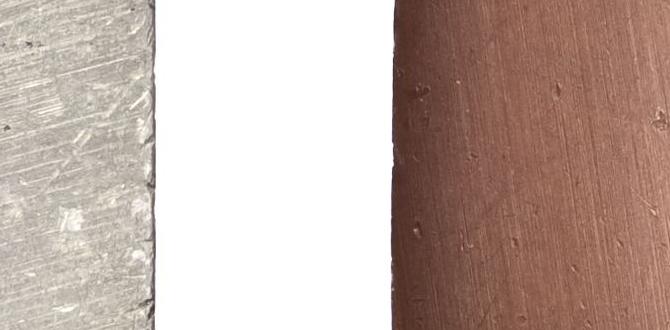Quick Summary:
A mini chuck for your lathe is a versatile tool for holding small workpieces. Choosing the right one involves understanding jaw types, mounting methods, and compatibility with your lathe. This guide helps beginners select the perfect mini chuck for precision and ease of use.
Hey there, fellow makers! Daniel Bates here from Lathe Hub. If you’ve just dipped your toes into the wonderful world of lathes, you’ve probably noticed how tricky it can be to hold onto those tiny, delicate project pieces. A standard chuck can feel like using a sledgehammer to crack a walnut! That’s where a mini chuck shines. It’s your secret weapon for precision work on smaller projects. Many beginners find themselves overwhelmed by the options, wondering if they’re making the right choice. Don’t worry, I’ve got your back! This guide will break down exactly what you need to know, step-by-step, so you can confidently pick out the perfect mini chuck for your lathe and your projects.
What Exactly is a Mini Chuck for a Lathe?
Think of a lathe chuck as the hands that hold your workpiece securely while the lathe spins. For larger projects, you’ll need a robust, standard chuck. But for smaller, more intricate items – like delicate pen barrels, small wooden bowls, or intricate metal components – a full-sized chuck can be overkill. This is where a mini chuck comes in. A mini chuck is essentially a smaller, lighter-duty version designed specifically for holding smaller diameter workpieces with more finesse and precision.
They offer a gentler grip and allow for much finer adjustments, which is crucial when you’re working with materials that might be easily damaged or when you need to achieve very tight tolerances. For hobbyists, woodturners, and those working on detailed metal projects, a mini chuck is not just a convenience; it’s often an essential tool that unlocks a new level of capability.
Why Do You Need a Mini Chuck? The Benefits Explained
So, why bother with a mini chuck when you might already have a larger one? The advantages are significant for specific tasks and types of projects. Let’s break them down:
- Precision and Control: This is the big one. Mini chucks offer finer jaw adjustments, allowing you to grip small, delicate items without applying excessive force. This means less risk of damaging your workpiece.
- Versatility for Small Projects: If you love turning pens, small boxes, intricate jewellery, or small metal parts, a mini chuck is practically a must-have. It’s designed to handle these smaller dimensions perfectly.
- Reduced Vibration: Their smaller size and lighter weight can sometimes lead to less vibration, especially on smaller or lighter lathes, resulting in cleaner cuts and smoother finishes.
- Cost-Effectiveness: Compared to large, industrial-grade chucks, mini chucks are generally more affordable, making them an accessible investment for beginners and hobbyists.
- Ease of Use: They are typically lighter and easier to mount and operate than their larger counterparts, which is a big plus for those new to lathe work.
- Specialized Jaws: Many mini chucks come with or have optional jaws specifically designed for unique shapes or difficult-to-hold items commonly found in smaller projects.
Understanding the Key Components of a Mini Chuck
Before we dive into buying, let’s get familiar with the parts of a mini chuck. Knowing these will help you understand the specifications and make informed decisions.
The Body
This is the main housing of the chuck. It contains the gearing mechanism that operates the jaws. The body size is usually measured by its diameter. For mini chucks, you’ll typically see them in the 2-3 inch range.
Jaws
These are the moving parts that grip the workpiece. Mini chucks usually come with a standard set of jaws, but you can often buy specialized jaws for different tasks. The type and design of the jaws are critical to what you can hold.
Mounting System
This is how the chuck attaches to your lathe’s headstock spindle. There are several common types, and ensuring compatibility is paramount.
Scroll or Gear Mechanism
This is the internal system that allows all jaws to move in unison when you turn the chuck key. It ensures the jaws are perfectly aligned and centered on your workpiece.
Types of Mini Chucks: Which is Right for You?
When you start looking, you’ll notice that mini chucks aren’t all the same. They primarily differ in their jaw-operating mechanisms, which affects what they can do and how they hold workpieces.
Scroll Chucks
These are the most common type, similar to their larger counterparts. A single scroll plate with spiral grooves moves all the jaws simultaneously when you turn the chuck key. This ensures the jaws remain centered.
- Pros: Excellent for centering, versatile, good for round or slightly irregular shapes, widely available.
- Cons: Can be slightly more complex internally.
Dovetail Jaws
Many mini chucks feature dovetail jaws. These jaws are angled to grip the dovetail or rebated base of a workpiece from the inside or outside. This is incredibly effective for holding bowls, lids, or other shapes with a specific rebated edge.
- Pros: Excellent for holding bowls securely, good for internal and external gripping of matching profiles.
- Cons: Less effective for irregular or completely cylindrical shapes without a rebate.
Pin Jaws / Gripper Jaws
These chucks use a series of small, sharp pins or specialized gripping surfaces to hold very small, often irregular or delicate, objects. They are fantastic for very small diameter workpieces or items that are difficult to grip with standard jaws.
- Pros: Ideal for tiny and irregular objects, can hold items with minimal surface contact.
- Cons: Not suitable for larger workpieces, can mar very soft materials.
4-Jaw Independent Chucks (Less Common in “Mini” Scale)
While less common in the true “mini” chuck category, some smaller lathes might use smaller versions of 4-jaw independent chucks. Each jaw moves independently, allowing you to grip non-round objects or precisely center them. For true mini work, scroll chucks with specialized jaws are usually preferred.
Essential Factors to Consider When Buying a Mini Chuck
Now that you know the types, let’s talk about the practicalities of choosing one. Getting this right saves you headaches later!
1. Lathe Spindle Thread Size
This is non-negotiable. Your mini chuck must match your lathe’s headstock spindle thread. Threads are measured in diameter and threads per inch (TPI). Common sizes include 1″ x 8 TPI, 3/4″ x 10 TPI, and various metric sizes like M33 x 3.5. Always check your lathe’s specifications in its manual!
Pro Tip: If the chuck doesn’t directly match your spindle, don’t despair! You can often buy an adapter (sometimes called a chuck adapter or insert) to make it fit. Just ensure the adapter is designed for your specific lathe spindle and the chuck thread.
2. Chuck Size and Jaw Capacity
Mini chucks typically range from about 2 to 3 inches in diameter. Consider the smallest and largest diameter workpieces you realistically plan to turn. Most mini chucks will specify their gripping range (e.g., 1/2″ to 2″ internal, 1″ to 3″ external). Make sure the chuck’s capacity aligns with your needs.
3. Jaw Type and Versatility
What will you be making most often?
- Woodturning (Pens, small bowls): Dovetail jaws are excellent for holding the base of bowls. Standard scroll jaws work well for the body of pens and turning the ends.
- Jewellery or Miniature Metalwork: Pin jaws or specialized small-part jaws are often best for delicate, intricate pieces.
Many mini chucks are sold with a standard set of jaws and offer optional sets for different tasks. Consider if buying extra jaws later is something you’d anticipate.
4. Jaw Mounting System (Direct Fit vs. Insert)
- Direct Thread Fit: The chuck threads directly onto your lathe spindle. Simple and secure, but you’re locked into that specific thread. This is less common for mini chucks often sold with inserts.
- Insert Type: The chuck has a female threaded hole that accepts a separate threaded insert. This is the most common and flexible system for mini chucks. You buy the chuck body and then purchase an insert that matches your lathe’s spindle thread. This means if you ever change lathes with a different spindle thread, you only need to buy a new insert, not a whole new chuck.
5. Build Quality and Material
Even for mini chucks, quality matters. Look for chucks made from hardened steel or robust aluminum alloys. Check reviews for user feedback on durability, precision, and how well the chuck holds its grip over time. A well-made chuck will last longer and provide more consistent results.
6. Brand Reputation and Support
Reputable brands often offer better quality control, customer support, and readily available spare parts or optional jaws. While you don’t always need the most expensive option, sticking to known brands in the lathe tool industry can be a safer bet for beginners.
7. Price and Budget
Mini chucks can range from under $100 to $300 or more. As a beginner, you don’t necessarily need the top-of-the-line model. Focus on a chuck that meets your immediate needs and has decent quality. You can always upgrade later if your projects demand it.
Top Mini Chuck Features for Beginners
Here are some specific features that make a mini chuck particularly beginner-friendly:
- Easy-to-Use Lever or Allen Key Operation: A smooth-operating chuck key mechanism is vital. Some levers are easier to turn than others.
- Clear Gripping Range Indicators: Some chucks have markings that help you gauge how far the jaws are extended or retracted.
- Included Wood Screw: Many mini chucks come with a wood screw attachment. This is incredibly useful for initial mounting of wood blanks, allowing you to face them off and then remove the screw to mount the blank into the chuck jaws.
- Comprehensive Instructions: Good manufacturers provide clear, step-by-step instructions not just for mounting but also for safe operation.
- Set of Optional Jaws: While not always standard, if a chuck comes with multiple jaw sets or has readily available options for pen jaws or spigot jaws, it adds a lot of value.
Step-by-Step Guide: Mounting Your Mini Chuck
Mounting your mini chuck correctly is crucial for safety and precision. Here’s a simplified process:
- Identify Your Lathe’s Spindle Thread: Consult your lathe’s manual. Note the diameter and TPI (e.g., 1″ x 8).
- Select the Correct Insert: If your chuck is an insert type, purchase an insert that matches your lathe’s spindle thread.
- Clean the Spindle Threads: Ensure both your lathe’s spindle threads and the chuck’s (or insert’s) threads are clean and free of debris or old lubricant. A clean thread ensures a snug, safe fit.
- Install the Insert (if applicable): Screw the correct insert onto your lathe’s spindle. Tighten it securely, often by using the chuck key to apply torque. Some manufacturers recommend a specific tightening method or torque setting, so check your manual. This is a critical step for stability.
- Attach the Mini Chuck: Screw the mini chuck onto the spindle (or the installed insert). Turn it clockwise by hand as far as it will go.
- Tighten the Chuck: Use the chuck key to tighten the chuck firmly onto the spindle. With a scroll chuck, tightening often involves turning the key in the chuck mechanism itself. Ensure it’s snug and doesn’t wobble. For safety, it’s often recommended to back it off a quarter turn and then tighten again firmly, or use a method recommended by the manufacturer of your specific chuck.
- Test for Runout: Mount a test indicator if you have one. Mount a known true round object (like a dial indicator holder or a piece of scrap metal rod) in the chuck and check for runout. Ideally, it should be very close to zero.
Always refer to your specific chuck and lathe manuals for detailed instructions. Safety first!
Table: Mini Chuck Buyer’s Checklist
Use this checklist to ensure you’re not missing any crucial details before hitting the ‘buy’ button.
| Feature | Consideration | Importance (for Beginners) | Notes |
|---|---|---|---|
| Lathe Spindle Thread Size | Does it match your lathe (e.g., 1″x8, M33x3.5)? | Critical | Use an insert or adapter if threads don’t match directly. |
| Chuck Diameter | Typical mini chucks are 2″-3″. | High | Choose based on your lathe size and typical project scale. |
| Jaw Capacity | Gripping range (min/max diameter). | High | Ensure it covers your smallest and largest intended workpieces. |
| Primary Jaw Type | Dovetail, Pin, Standard Scroll? | High | Matches your most common project types (e.g., bowls vs. pens). |
| Insert Compatibility | Does it use interchangeable inserts? | High | Offers future flexibility if you change lathes. |
| Jaw Material & Hardness | Hardened steel is durable. | Medium-High | Affects longevity and grip reliability. |
| Build Quality | Smooth operation, solid construction. | High | Look for reputable brands and read reviews. |
| Included Accessories | Wood screw, extra keys, carry case? | Medium | Adds value and immediate usability. |
| Optional Jaws Availability | Can you buy specialized jaws later? | Medium | For expanding your capabilities. |
| Price | Within your budget? | High | Balance features with cost. A quality mid-range is often best for beginners. |
Popular Mini Chuck Brands and What They Offer
While I can’t recommend specific models without knowing your exact lathe, here are some well-regarded brands known for producing quality mini chucks. These names often appear in discussions on forums like Woodworking Stack Exchange or on reputable woodworking and machining sites.
- Teknatool (Nova): Nova chucks, including their mini options, are very popular, especially in the woodturning community. They are known for their robust build, innovation, and excellent jaw systems. They often use a direct-thread or insert system and offer a wide array of specialized jaws.
- Oneway: Oneway is a highly respected name in woodturning. Their chucks are known for precision, durability, and a unique jaw design that offers excellent grip. While they might be at a higher price point, their quality is often considered top-tier.
- Record Power: This brand offers a range of chucks, including mini options, that often provide a good balance of quality and affordability. They are a solid choice for hobbyists looking for reliable performance.
- Charnwood: A UK-based brand that provides a good range of woodworking tools, including chucks. Their mini chucks are often seen as a good value proposition for the home workshop.
- Various “Generic” or “Budget” Brands: You’ll find many mini chucks on online marketplaces from less established brands. While some can be surprisingly good for the price, it’s crucial to do thorough research, read many reviews, and understand that build quality and longevity might be more variable. For a beginner, sticking with established brands if budget allows is often a safer bet.
Always remember to check compatibility with your specific lathe spindle thread when looking at any brand.
Mini Chuck Maintenance and Care
Keeping your mini chuck in good shape ensures it performs reliably and lasts for years. It’s pretty straightforward:
- Clean After Use: After each use, especially with wood or dusty materials, wipe down the chuck body and jaws with a clean, dry cloth. Brush out any dust or debris from the jaw mechanisms.
- Lubrication: Periodically lubricate the scroll and jaw slides according to the manufacturer’s instructions. A little grease or specialized chuck lubricant can make a big difference in smooth operation.







